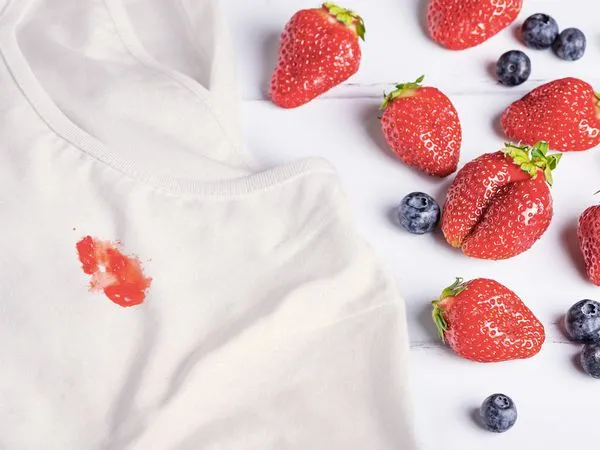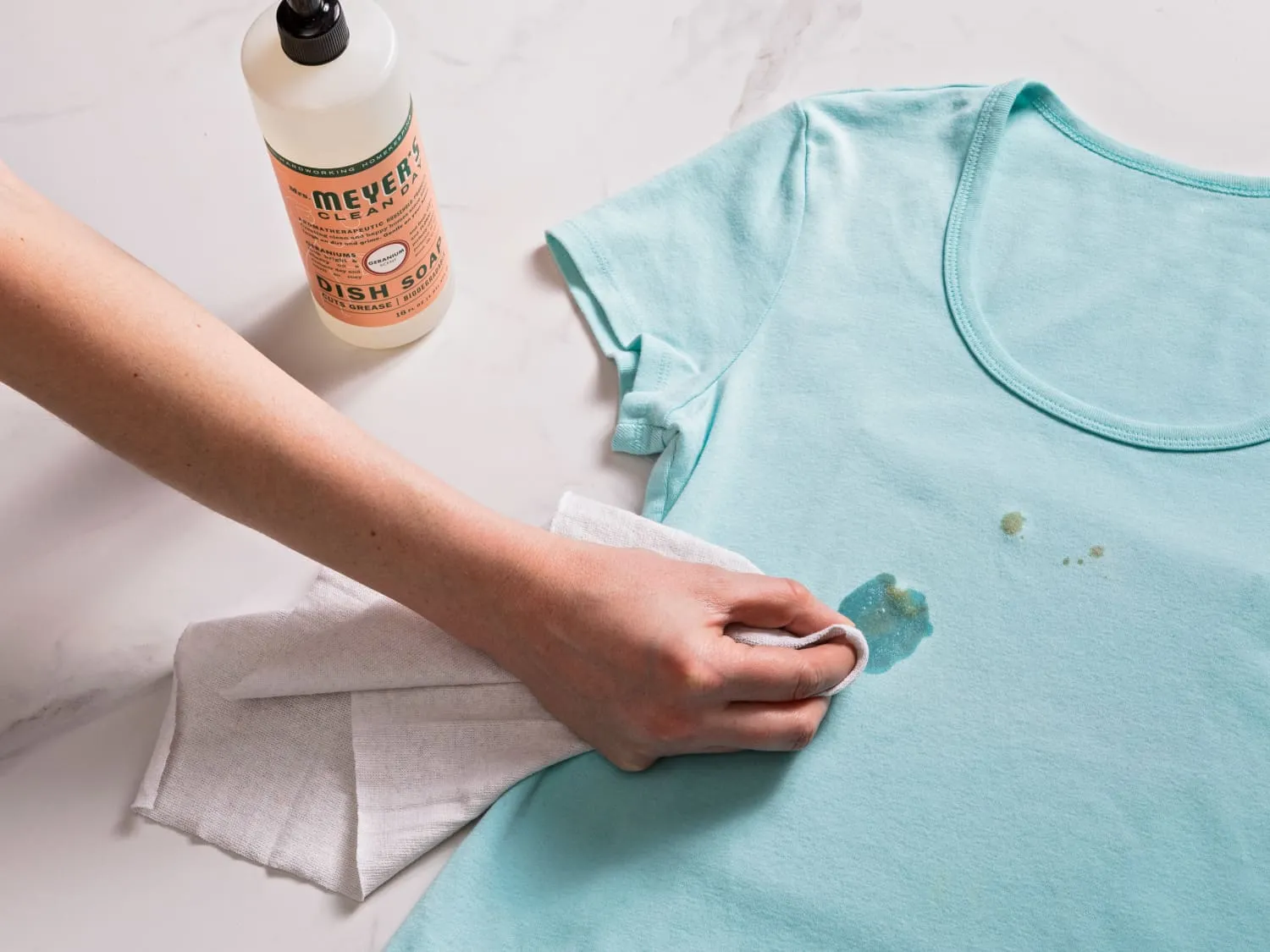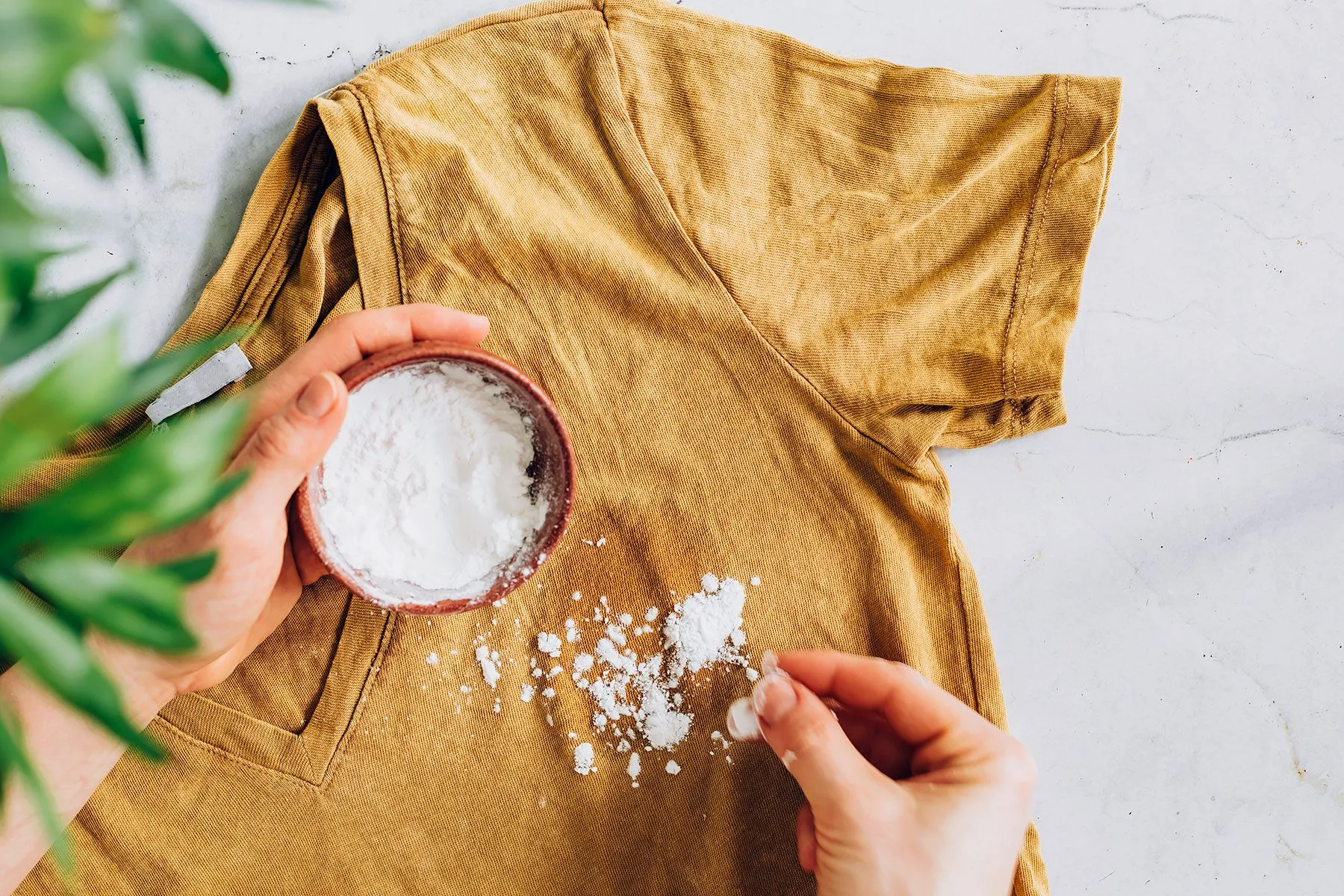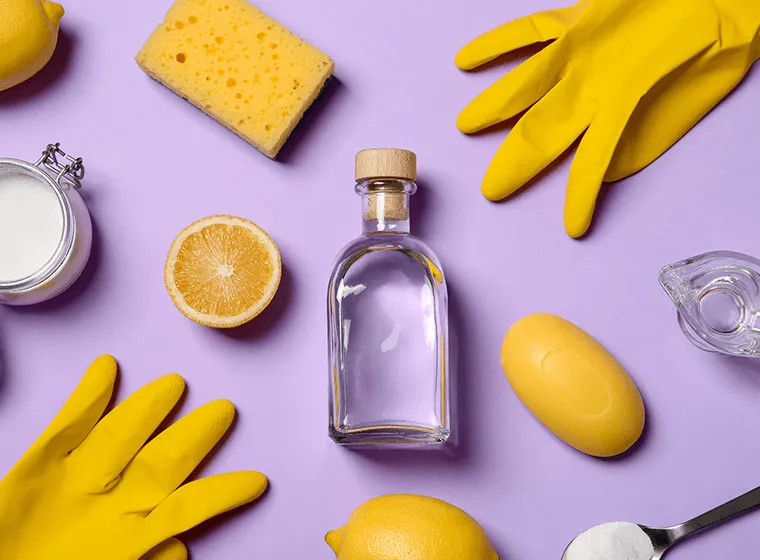Like almost all other stains, you should remove fruit stains when they are still fresh. This applies not only to highly visible red stains, but also to those from light-colored fruit such as apples or pears. You can find out how to go about it and what difference the substances make here. In addition, the removal of dried stains is addressed. There are several ways to remove stains from textiles such as clothing and carpets.
✔️Raspberries lie on a red-stained light blue tablecloth.
✔️If you remove fruit stains as soon as possible, usually no residue will remain.
✔️Dried fruit stains need special treatment.
Table of Contents
Remove fresh fruit stain

If you notice the mishap immediately, you should first remove the pulp with a dry kitchen towel and gently dab the stain. Don’t rub over the fabric, though, or you’ll just spread the colored liquid inside! In the second step, dip a rag in clear water and gently work the stain with it.
Water should be put on the clothing or at the very least the area affected by the stain, if possible. As the carbonic acid in mineral water keeps the fruit juices from sticking to the fibers, it is even better than tap water. If the stain does not disappear, there are several home remedies you can try your luck with, such as:
- Vinegar
- Lemon juice
- milk
- yogurt
- Toothpaste
- Salt
Mix the vinegar or citric acid with water in a ratio of 1:2 and soak the clothes in it for at least half an hour. Be careful with dark clothes and lemon juice: it can possibly attack the colors.
Using milk and yogurt overnight works best: The enzymes and microorganisms they contain prevent stains from setting in permanently. If that is not possible, scrub the stains with toothpaste and salt. Pretreatment should always be followed by a normal wash in the washing machine. Bleach can be used to lighten up pieces that are lighter in color (colored textiles may fade as a result).
Old stains you should give special treatment
If you discover the stains only when they have already dried up, or you were on the road, you cannot remove them early. Sometimes it also turns out only after washing that the stains cannot be washed out. In these cases, the home remedies mentioned above are not enough.
To remove stubborn stains, it is necessary to pre-treat the clothes

First, soak dried stains in a little soapy water. After a few minutes, remove the garment and generously rub bile soap on it or sprinkle stain salt on the affected area. Leave the respective agent to work for half an hour, wash out the spot and put the soap or salt on it again. Finally, with the detergent of your choice, the textile goes into the washing machine.
Tip: You can remove fruit stains from cotton by treating them with high-proof alcohol from the pharmacy.
How to remove washed-in fruit stains from textiles

Before washing the soiled clothing, you should always pre-treat it to get rid of fruit stains. You may use bile soap or stain salts to remove stains if they remain after washing. If these agents don’t yield desired results, consider cleaning gasoline – there are varieties specifically designed to remove fruit stains.
Caution: Try the benzene on an inconspicuous spot first – it may attack the colors of the clothes!
Cleaning Deep Pile Carpets-Home Remedies and Tips Cleaning Exterior Wall :How To Make Your House Shine Again
How to remove fruit stains from the carpet

Child lies on light carpet and bites into a melon
Sometimes you need to remove fruit stains from the carpet as well.
Carpets cannot be washed by simply soaking them in water. In order to remove fruit stains, you should also follow these suggestions: If the carpet is light-colored and the stain is fresh, first soak up as much juice as possible, and then treat the stain with lemon juice.
Depending on the stain color, you may need to wash the spot with water twice, and then use baking soda to remove the stain if you let it soak overnight. Just vacuum it away in the morning. In addition to spraying glass cleaner on the carpet, rubbing it in and letting it soak in, if the stain is stubborn, you can also apply rubbing alcohol. Alternatively, use some mild detergent to treat the stain.
Tip: In any case, the carpet should dry thoroughly before you walk on the spot again!
4 How to remove fruit stains from walls and floors

If you crush a berry accidentally, most floors like vinyl and laminate can be mopped. If you wipe the parquet and plank floors dry after treating them with a damp cloth, you can also treat them with a damp cloth in the appropriate place. By rubbing fruit juice into wood, the wood will become permanently discolored. The stains must be removed completely with fine sandpaper, or to make the floor more resistant, sand the floor completely and seal it afterwards.
Dark stains on the walls, on the other hand, may be more difficult to remove. It is best to wipe them off immediately. From tiles or tiles, you can simply remove them with warm water.
An eraser in a colorless or white solution can be used to remove dried fruit stains from the wall. A paste made from cornstarch and water can also be applied to walls that aren’t colorfully painted or wallpapered. The stain will disappear if you let it dry overnight and brush it off the next morning.
Attention: The latter tip is not suitable for wallpaper – it may come off the wall!
Instructions for removing fruit stains

- Dabbing
You should first use a kitchen towel to rub on new stains. Do not rub the stain, instead just dab at it with a kitchen towel. Rubbishing on fruits can leave stains that will be more difficult to remove.
2. Treat the stain
Pre-treating your textile before you wash it will help prevent the dye from clinging to it. Pre-treating the stain will make it easier to remove. Also, it is important to get rid of any stains from dried or old fruit. Use a home remedy that is suitable for the situation based on the fabric’s color and surface.
3. Let it work!
You should leave the remedy on for at least 30 mins to get the best results. For home remedies like this, milk or washing soda can also be left on for up to an hour.
4. Wash
Rinse the stain remover gently after it has dried for the appropriate time. Then wash the stain remover in the machine as normal. Fruit stains should disappear after the treatment is completed.
5. Continue the process
Repeat the whole process if the fruit stains remain after washing the machine.
These home remedies can be used to prevent fruit stains

Mineral water: This dilutes cherry stains and makes them easier to remove from textiles. Carbonated mineral water (CO2) is even more effective because it contains carbon dioxide (CO2), which binds moisture from new stains and helps to remove them from textile fibers.
Vinegar and lemon juice: Vinegar and lemon juice dissolve the tannic acids in juice. This prevents the stain settling in textile fibers and makes them paler. The textiles can be washed as normal after treatment.
Buttermilk: Buttermilk is rich in microorganisms as well as enzymes. These enzymes, which are similar to acid, prevent the tannic acids found in many fruits from settling in textile fibers. You can soak the pieces in buttermilk and rinse them after washing.
Salt: Salt attracts moisture quickly. Normal table salt can be used as an immediate solution to fruit stains. You must cover the stain with salt until it is completely dried. Next, tap the salt off and wash the garment.
Sunlight: While UV light isn’t a cleaning agent it can have a bleaching effect. If you still have yellow stains on white textiles, you can either put them in direct sunlight or hang them out in the sun for a few hours. This trick is only applicable to light-colored clothing and it only works during warm seasons.
Soap and detergent: Detergents and soaps that are formulated for fruit stain prevention can also be used. Use water to moisten the area and then use soap to rub the stain. Wash as usual.